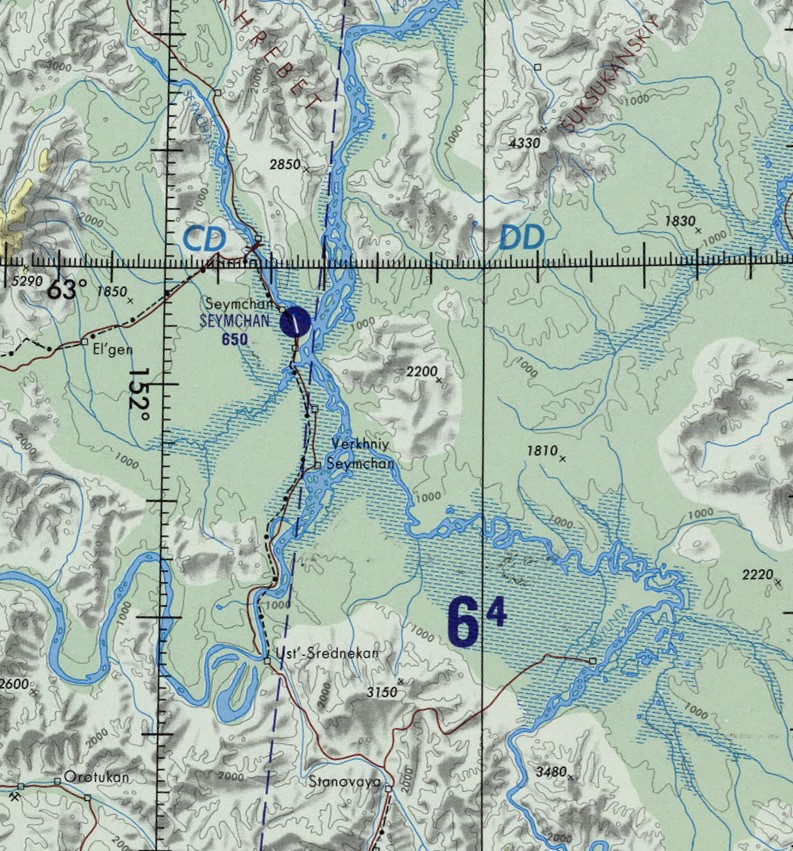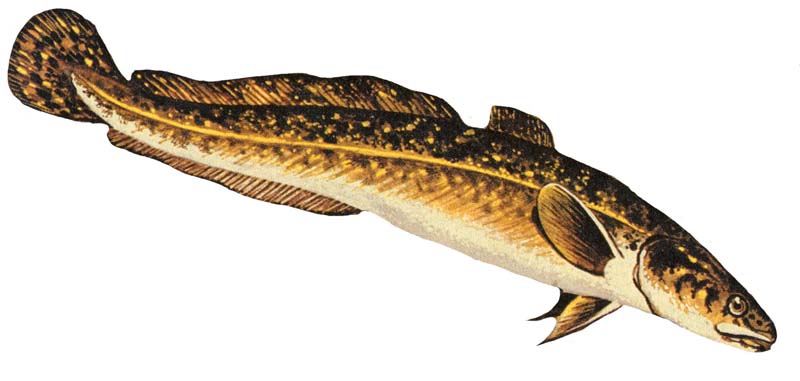|
Buyunda
The Buyunda (russian: Буюнда) is a river in Magadan Oblast, Russian Far East. It is a right tributary of the Kolyma, with a length of and a drainage basin of .Google Earth Together with the Seymchan that flows roughly southwards on the facing bank of the Kolyma basin, the Buyunda forms the Seymchan-Buyunda Depression, which limits the Upper Kolyma Highlands from the east. The name of the Buyunda originated in the Evenki language, meaning "where there are wild deer". Course The Buyunda is the seventh longest tributary of the Kolyma. It has its sources in the Kilgan Massif and heads roughly northwards across the mountainous area of the Maymandzhin Range. After entering the depression it meanders strongly across a wide and marshy floodplain, its main channel dividing into branches. Finally the river joins the right bank of the Kolyma from its mouth. Its confluence with the Kolyma is 100 km below the Ust-Srednekan Hydroelectric Station. Seymchan settlement and the ... [...More Info...] [...Related Items...] OR: [Wikipedia] [Google] [Baidu] |
Seymchan (Kolyma)
The Seymchan (russian: Сеймчан) is a river in Srednekansky District, Magadan Oblast, Russia. It is a left tributary of the Kolyma, with a length of a drainage basin of . The name comes from the Yakut language word Kheymchen, which is an area of open water surrounded by sea ice.W.J. Stringer and J.E. Groves. 1991''Extent of Polynyas in the Bering and Chukchi Seas''/ref> Course The river rises in the Upper Kolyma Highlands, eastern limits of the Chersky Range, at the confluence of Left Seymchan and Right Seymchan. It flows first in a northeast direction, bending along its course until it flows in a southeastern direction. Finally it meets the Kolyma near Seymchan, from its mouth, downstream from the mouth of the Buyunda on the opposite bank. Together with the Buyunda that flows roughly northwards on the other side of the Kolyma basin, the Seymchan forms the Seymchan-Buyunda Depression, which limits the Upper Kolyma Highlands from the east. Its main tributaries are the ... [...More Info...] [...Related Items...] OR: [Wikipedia] [Google] [Baidu] |
Maymandzhin Range
The Maymandzhin Range ( rus, Майманджинский хребет) is a mountain range in Magadan Oblast, Far Eastern Federal District, Russia.Google EarthКонгинский хребет in 30 vols. / Ch. ed. – 3rd ed. – M, 1969-1978. One of the possible routes of the projected Lena-Kamchatka railway line is across the Maymandzhin Range. [...More Info...] [...Related Items...] OR: [Wikipedia] [Google] [Baidu] |
Kolyma Mountains
The Kolyma Mountains or Kolyma Upland ( rus, Колымское нагорье, r=Kolymskoye Nagorye) is a system of mountain ranges in northeastern Siberia, lying mostly within the Magadan Oblast, along the shores of the Sea of Okhotsk in the Kolyma region. The range's highest point is Mount Nevskaya (гора Невская) in the Omsukchan Range at . Geography The Kolyma Mountains stretch on a NW-SW alignment and consists of a series of plateaus and ridges punctuated by granite peaks that typically range between . To the west and southwest the Upper Kolyma Highlands are bound by the Seymchan- Buyunda Depression to the north and the Ola river basin to the south. The Yukaghir Highlands, highest point Mount Chubukulakh, rise to the northwest, the Anadyr Highlands to the north and northeast and the Koryak Highlands to the east.Google Earth Subranges Besides the Omsukchan Range, the system of the Kolyma Mountains comprises a number of subranges. Most are located in Magadan Obl ... [...More Info...] [...Related Items...] OR: [Wikipedia] [Google] [Baidu] |
Kolyma (river)
The Kolyma ( rus, Колыма, p=kəlɨˈma; sah, Халыма, translit=Khalyma) is a river in northeastern Siberia, whose basin covers parts of the Sakha Republic, Chukotka Autonomous Okrug, and Magadan Oblast of Russia. The Kolyma is frozen to depths of several metres for about 250 days each year, becoming free of ice only in early June, until October. Course The Kolyma begins at the confluence of the Kulu and the Ayan-Yuryakh, originating in the Khalkan Range and flows across the Upper Kolyma Highlands in its upper course. Leaving the mountainous areas it flows roughly northwards across the Kolyma Lowland, a vast plain dotted with thousands of lakes, part of the greater East Siberian Lowland. The river empties into the Kolyma Gulf of the East Siberian Sea, a division of the Arctic Ocean. The Kolyma is long. The area of its basin is . The average discharge at Kolymskoye is , with a high of reported in June 1985, and a low of in April 1979. Tributaries The ma ... [...More Info...] [...Related Items...] OR: [Wikipedia] [Google] [Baidu] |
Seymchan (urban-type Settlement)
Seymchan ( rus, Сеймча́н, p=sʲɪjmˈtɕan) is an urban locality (an urban-type settlement) and the administrative center of Srednekansky District of Magadan Oblast, Russia. Population: Geography Seymchan is located in the Seymchan-Buyunda Depression, which limits the Upper Kolyma Highlands from the east. The town lies on the right bank of the Seymchan River, near its confluence with the Kolyma, about north of Magadan.Google Earth History The settlement was founded in the late 17th century by Yakuts. Its name derives from the Yakut language word ''Kheymchen'', meaning Polynya. In the 19th century, the trade route between the Kolyma region and the Sea of Okhotsk, the ''Ola-Kolyma-Trakt'' was constructed through the settlement. Economic development of the settlement increased with the opening of the first gold mines in 1931, and the discovery and later exploitation of brown coal reserves at Elgen in 1932, tin reserves in 1937 and cobalt ore in the early 1940s. Th ... [...More Info...] [...Related Items...] OR: [Wikipedia] [Google] [Baidu] |
Upper Kolyma Highlands
The Upper Kolyma Highlands ( rus, Верхнеколымское нагорье) is a highland area in Magadan Oblast, Far Eastern Federal District, Russia. The biggest town in the highlands is Susuman. There are large deposits of gold, tin and rare metals in the Upper Kolyma Highlands. The area is relatively less desolate than other mountainous zones of Northeastern Siberia, such as the Yukaghir Highlands or the Nera Plateau. However, some of the mining operations were deemed unprofitable following the collapse of the USSR and certain settlements of the Susumansky District lost population. Only a residual population remains in Shiroky, Kholodny and Bolshevik. Other places such as Belichan and Kadykchan have become ghost towns. The R504 Kolyma Highway crosses the southern part of the highlands. Geography The Upper Kolyma Highlands are located in the upper course of the Kolyma. They are bound in the west by the Tas-Kystabyt and Suntar-Khayata ranges and to the east by the ... [...More Info...] [...Related Items...] OR: [Wikipedia] [Google] [Baidu] |
List Of Rivers Of Russia
Russia can be divided into a European and an Asian part. The dividing line is generally considered to be the Ural Mountains. The European part is drained into the Arctic Ocean, Baltic Sea, Black Sea, and Caspian Sea. The Asian part is drained into the Arctic Ocean and the Pacific Ocean. Notable rivers of Russia in Europe are Volga (which is the longest river in Europe), Pechora, Don, Kama, Oka and the Northern Dvina, while several other rivers originate in Russia but flow into other countries, such as the Dnieper and the Western Dvina. In Asia, important rivers are the Ob, the Irtysh, the Yenisei, the Angara, the Lena, the Amur, the Yana, the Indigirka, and the Kolyma. In the list below, the rivers are grouped by the seas or oceans into which they flow. Rivers that flow into other rivers are ordered by the proximity of their point of confluence to the mouth of the main river, i.e., the lower in the list, the more upstream. There is an alphabetical list of rivers at the end of ... [...More Info...] [...Related Items...] OR: [Wikipedia] [Google] [Baidu] |
Google Earth
Google Earth is a computer program that renders a 3D computer graphics, 3D representation of Earth based primarily on satellite imagery. The program maps the Earth by superimposition, superimposing satellite images, aerial photography, and geographic information system, GIS data onto a 3D globe, allowing users to see cities and landscapes from various angles. Users can explore the globe by entering addresses and coordinates, or by using a Computer keyboard, keyboard or computer mouse, mouse. The program can also be downloaded on a smartphone or Tablet computer, tablet, using a touch screen or stylus to navigate. Users may use the program to add their own data using Keyhole Markup Language and upload them through various sources, such as forums or blogs. Google Earth is able to show various kinds of images overlaid on the surface of the earth and is also a Web Map Service client. In 2019, Google has revealed that Google Earth now covers more than 97 percent of the world, and has c ... [...More Info...] [...Related Items...] OR: [Wikipedia] [Google] [Baidu] |
Lenok
Lenoks, otherwise known as Asiatic trout or Manchurian trout,James Card: Fly fishing in South Korea.' Retrieved 22 June 2015. are salmonid fish of the genus ''Brachymystax'', native to rivers and lakes in Mongolia, Kazakhstan, wider Siberia (including Russian Far East), Northern China and Korea.Kartavtseva, I.V.; Ginatulina, L.K.; Nemkova, G.A.; and Shedko, S.V. (2013). Chromosomal study of the lenoks, Brachymystax (Salmoniformes, Salmonidae) from the South of the Russian Far East.' Journal of Species Research 2(1): 91-98. Species There are four species in this genus, of which three are listed by FishBase: * ''Brachymystax lenok'' (Pallas, 1773) – sharp-snouted lenok * '' Brachymystax savinovi'' Mitrofanov, 1959 * '' Brachymystax tumensis'' T. Mori, 1930 – blunt-snouted lenok A fourth species, '' Brachymystax tsinlingensis'' S. C. Li, 1966, was revalidated in 2015. Traditionally, only ''B. lenok'' was recognized, including both sharp-snouted and blunt-snouted forms. Base ... [...More Info...] [...Related Items...] OR: [Wikipedia] [Google] [Baidu] |
Burbot
The burbot (''Lota lota'') is the only gadiform (cod-like) freshwater fish Freshwater fish are those that spend some or all of their lives in fresh water, such as rivers and lakes, with a salinity of less than 1.05%. These environments differ from marine conditions in many ways, especially the difference in levels of .... It is also known as bubbot, mariah, loche, cusk, freshwater cod, freshwater ling, freshwater cusk, the lawyer, coney-fish, lingcod, and eelpout. The species is closely related to the marine common ling and the cusk (fish), cusk. It is the monotypic, only member of the genus ''Lota''. For some time of the year, the burbot lives under ice, and it requires frigid temperatures to breed. Etymology The name burbot comes from the Latin word ''barba'', meaning beard, referring to its single chin whisker, or barbel (anatomy), barbel. Its generic and specific names, ''Lota lota'', comes from the old French ''lotte'' fish, which is also named "barbot" in Old French. ... [...More Info...] [...Related Items...] OR: [Wikipedia] [Google] [Baidu] |
Coregonus
''Coregonus'' is a diverse genus of fish in the salmon family (Salmonidae). The ''Coregonus'' species are known as whitefishes. The genus contains at least 68 described extant taxa, but the true number of species is a matter of debate. The type species of the genus is '' Coregonus lavaretus''. Most ''Coregonus'' species inhabit lakes and rivers, and several species, including the Arctic cisco (''C. autumnalis''), the Bering cisco (''C. laurettae''), and the least cisco (''C. sardinella'') are anadromous, moving between salt water and fresh water. Many whitefish species or ecotypes, especially from the Great Lakes and the Alpine lakes of Europe, have gone extinct over the past century or are endangered. Among 12 freshwater fish considered extinct in Europe, 6 are ''Coregonus''. All ''Coregonus'' species are protected under appendix III of the Bern Convention. Taxonomy Phylogenetic evidence indicates that the most basal member of the genus is the highly endang ... [...More Info...] [...Related Items...] OR: [Wikipedia] [Google] [Baidu] |



.jpg)


